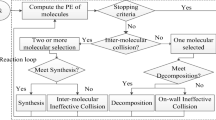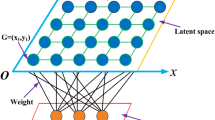Abstract
Two goals of multi-objective evolutionary algorithms are effectively improving their convergence and diversity and making the Pareto set evenly distributed and close to the real Pareto front. At present, the challenges to be solved by the multi-objective evolutionary algorithm are to improve the convergence and diversity of the algorithm, and how to better solve functions with complex PF and/or PS shapes. Therefore, this paper proposes a gray wolf optimization-based self-organizing fuzzy multi-objective evolutionary algorithm. Gray wolf optimization algorithm is used to optimize the initial weights of the self-organizing map network. New neighborhood relationships for individuals are built by self-organizing map, which can maintain the invariance of feature distribution and map the structural information of the current population into Pareto sets. Based on this neighborhood relationship, this paper uses the fuzzy differential evolution operator, which constructs a fuzzy inference system to dynamically adjust the weighting parameter in the differential operator, to generate a new initial solution, and the polynomial mutation operator to refine them. Boundary processing is then conducted. Experiments on 15 problems of GLT1-6 and WFG1-9 and the algorithm proposed in this paper achieve the best on 18 values. And the result shows that the convergence and diversity of the proposed algorithm are better than several state-of-the-art multi-objective evolutionary algorithms.











Similar content being viewed by others
Data availability
Enquiries about data availability should be directed to the authors.
References
Alsattar H, Zaidan A, Zaidan B (2020) Novel meta-heuristic bald eagle search optimisation algorithm. Artif Intell Rev 53(6):2237–2264
Angayarkanni S, Sivakumar R, Rao Y (2021) Hybrid grey wolf: bald eagle search optimized support vector regression for traffic flow forecasting. J Ambient Intell Human Comput 12(1):1293–1304
Bošković B, Brest J (2018) Protein folding optimization using differential evolution extended with local search and component reinitialization. Inf Sci 454:178–199
Cai XY, Xiao YS, Li MQ, Hu H, Ishibuchi H, Li XP (2020) A grid-based inverted generational distance for multi/many-objective optimization. IEEE Trans Evol Comput 25(1):21–34
Chen DB, Zou F, Lu RQ, Wang XD (2018) A hybrid fuzzy inference prediction strategy for dynamic multi-objective optimization. Swarm Evol Comput 43:147–165
Durillo JJ, Nebro AJ, Luna F, Alba E (2008) Solving three-objective optimization problems using a new hybrid cellular genetic algorithm. International conference on parallel problem solving from nature. Springer, Berlin, pp 661–670
Elhariri E, El-Bendary N, Hassanien AE, Abraham A (2015) Grey wolf optimization for one-against-one multi-class support vector machines. In: 2015 7th international conference of soft computing and pattern recognition (SoCPaR). IEEE, pp 7–12
Elhariri E, El-Bendary N, Hassanien AE (2016) A hybrid classification model for EMG signals using grey wolf optimizer and SVMs. In: The 1st international conference on advanced intelligent system and informatics (AISI2015), November 28–30, 2015. Springer, Beni Suef, Egypt, pp 297–307
Gu FQ, Liu HL, Tan KC (2012) A multiobjective evolutionary algorithm using dynamic weight design method. Int J Innov Comput Inf Control 8(5B):3677–3688
Huband S, Barone L, While L, Hingston P (2005) A scalable multi-objective test problem toolkit. In: International conference on evolutionary multi-criterion optimization. Springer, pp 280–295
Kohonen T (1990) The self-organizing map. Proc IEEE 78(9):1464–1480
Korashy A, Kamel S, Nasrat L, Jurado F (2020) Developed multi-objective grey wolf optimizer with fuzzy logic decision-making tool for direction overcurrent relays coordination. Soft Comput 24(17):13305–13317
Lara A, Sanchez G, Coello CAC, Schutze O (2010) HCS: a new local search strategy for memetic multiobjective evolutionary algorithms. IEEE Trans Evol Comput 14(1):112–132
Li H, Zhang QF (2009) Multiobjective optimization problems with complicated pareto sets, MOEA/D and NSGA-II. IEEE Trans Evol Comput 13(2):284–302
Li SM, Chen HL, Wang MJ, Heidari AA, Mirjalili S (2020) Slime mould algorithm: a new method for stochastic optimization. Futur Gener Comput Syst 111:300–323
Liang J, Guo QQ, Yue CT, Qu BY (2019) Self-organizing multi-objective particle swarm optimization algorithm. Appl Res Comput 36(8):2311–2316
Marler RT, Arora JS (2004) Survey of multi-objective optimization methods for engineering. Struct Multidiscip Optim 26(6):369–395
Melin P, Olivas F, Castillo O, Valdez F, Soria J, Valdez M (2013) Optimal design of fuzzy classification systems using PSO with dynamic parameter adaptation through fuzzy logic. Expert Syst Appl 40(8):3196–3206
Mendes R, Mohais AS (2005) DynDE: a differential evolution for dynamic optimization problems. 2005 IEEE congress on evolutionary computation 3:2808–2815
Ming MJ, Wang R, Zha YB, Zhang T (2017) Pareto adaptive penalty-based boundary intersection method for multi-objective optimization. Inf Sci 414:158–174
Mirjalili S, Mirjalili SM, Lewis A (2014) Grey wolf optimizer. Adv Eng Softw 69(3):46–61
Mostafa M, Rezk H, Aly M, Ahmed EM (2020) A new strategy based on slime mould algorithm to extract the optimal model parameters of solar pv panel. Sustain Energy Technol Assess 42:100849–100861
Mustaffa Z, Sulaiman MH, Kahar MNM (2015) Training LSSVM with GWO for price forecasting. In: 2015 international conference on informatics. Electronics and vision (ICIEV). IEEE, pp 1–6
Nebro AJ, Durillo JJ, Luna F, Dorronsoro B, Alba E (2009) MOCell: a cellular genetic algorithm for multiobjective optimization. Int J Intell Syst 24(7):726–746
Norouzi K, Rakhshandehroo GR (2011) A self organizing map based hybrid multi-objective optimization of water distribution networks. Iran J Sci Technol Trans B Eng 35(1):105–119
Olivas F, Valdez F, Castillo O, Gonzalez CI, Martinez G, Melin P (2017) Ant colony optimization with dynamic parameter adaptation based on interval type-2 fuzzy logic systems. Appl Soft Comput 53:74–87
Price KV, Storn RM, Lampinen JA (2005) Differential evolution-A practical approach to global optimization. Springer, Berlin
Sankhwar S, Gupta D, Ramya KC, Rani SS, Shankar K, Lakshmanaprabu SK (2020) Improved grey wolf optimization-based feature subset selection with fuzzy neural classifier for financial crisis prediction. Soft Comput 24(1):101–110
Santiago A, Dorronsoro B, Nebro AJ, Durillo JJ, Fraire HJ (2019) A novel multi-objective evolutionary algorithm with fuzzy logic based adaptive selection of operators: FAME. Inf Sci 471:233–251
Saremi S, Mirjalili SZ, Mirjalili SM (2015) Evolutionary population dynamics and grey wolf optimizer. Neural Comput Appl 26(5):1257–1263
Shen YP, Ge GR (2019) Multi-objective particle swarm optimization based on fuzzy optimality. IEEE Access 7:101513–101526
Sivanandam N, Sai S, Deepa SN (2007) Introduction to fuzzy logic using MATLAB. Springer, Berlin
Song HJ, Miao CY, Shen ZQ (2007) Fuzzy cognitive map learning based on multi-objectiveparticle swarm optimization. In: Proceedings of the 9th annual conference on Genetic and evolutionary computation, pp 339–339
Storn R (1996) On the usage of differential evolution for function optimization. In: Fuzzy information processing society, Nafips Biennial Conference of the North American, pp 519–523
Teuvo K (1998) The self-organizing map. Neurocomputing 21(1):1–6
Wang LP, Zhang QF, Min ZA, Gong MG, Jiao LC (2016) Constrained subproblems in decomposition based multiobjective evolutionary algorithm. IEEE Trans Evol Comput 20(3):475–480
Xie JL, Zhang SL, Lin L (2021) Prediction of network public opinion based on bald eagle algorithm optimized radial basis function neural network. Int J Intell Comput Cybern. https://doi.org/10.1108/IJICC-07-2021-0148
Yogesh G, Ashish S (2019) A new swarm-based efficient data clustering approach using KHM and fuzzy logic. Soft Comput 23(1):145–162
Zhang H, Song SM, Zhou AM, Gao XZ (2015) A multiobjective cellular genetic algorithm based on 3D structure and cosine crowding measurement. Int J Mach Learn Cybern 6(3):487–500
Zhang H, Zhou AM, Song SM, Zhang QF, Gao XZ, Zhang J (2016) A self-organizing multiobjective evolutionary algorithm. IEEE Trans Evol Comput 20(5):792–806
Zhang QF, Zhou AM, Jin YC (2008) RM-MEDA: a regularity model-based multiobjective estimation of distribution algorithm. IEEE Trans Evol Comput 12(1):41–63
Zhou AM, Zhang QF (2016) Are all the subproblems equally important? Resource allocation in decomposition-based multiobjective evolutionary algorithms. IEEE Trans Evol Comput 20(1):52–64
Zhou AM, Zhang QF, Jin YC, Tsang E (2005) A model-based evolutionary algorithm for bi-objective optimization. In: 2005 IEEE congress on evolutionary computation, vol 3, pp 2568–2575
Zhou AM, Zhang QF, Jin YC (2009) Approximating the set of pareto-optimal solutions in both the decision and objective spaces by an estimation of distribution algorithm. IEEE Trans Evol Comput 13(5):1167–1189
Zitzler E, Thiele L (1999) Multiobjective evolutionary algorithms: a comparative case study and the strength pareto approach. IEEE Trans Evol Comput 3(4):257–271
Zou F, Chen DB, Xu QZ, Lu RQ (2020) A new prediction strategy combining T-S fuzzy nonlinear regression prediction and multi-step prediction for dynamic multi-objective optimization. Swarm Evol Comput 59:100749–100768
Funding
This work was supported in part by the National Natural Science Foundation of China (Nos. 12271211,12071179), the National Natural Science Foundation of Fujian Province (Nos. 2021J01861), Soft Science Research Program of Fujian Province (No. B19085), the Project of Education Department of Fujian Province (No. JT180263), the Youth Innovation Fund of Xiamen City (3502Z20206020), the Open Fund of Digital Fujian Big Data Modeling and Intelligent Computing Institute, Pre-Research Fund of Jimei University.
Author information
Authors and Affiliations
Contributions
Jialiang Xie gave the overall framework of the paper and introduction, and Shanli Zhang completed the experiment and the first draft. Honghui Wang modified the grammar of the paper, and Dongrui Wu coordinated the paper.
Corresponding author
Ethics declarations
Conflict of interest
All authors declare that they have no conflict of interest.
Ethical approval
This article does not contain any studies with human participants or animals performed by any of the authors.
Informed consent
Informed consent was obtained from all individual participants included in the study.
Additional information
Publisher's Note
Springer Nature remains neutral with regard to jurisdictional claims in published maps and institutional affiliations.
Rights and permissions
Springer Nature or its licensor holds exclusive rights to this article under a publishing agreement with the author(s) or other rightsholder(s); author self-archiving of the accepted manuscript version of this article is solely governed by the terms of such publishing agreement and applicable law.
About this article
Cite this article
Xie, J., Zhang, S., Wang, H. et al. Gray wolf optimization-based self-organizing fuzzy multi-objective evolution algorithm. Soft Comput 26, 12077–12092 (2022). https://doi.org/10.1007/s00500-022-07492-z
Accepted:
Published:
Issue Date:
DOI: https://doi.org/10.1007/s00500-022-07492-z




